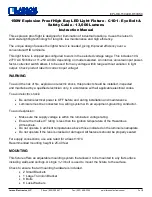
504-2056A 14
1.
Controls for Inspiratory and Expiratory Times
These calibrated rotary controls give continuous adjustment of time over a range of 0.25 to
2.0 seconds for inspiration and 0.25 to 4.0 seconds for expiration.
Normally these two controls will be adjusted independently to set the optimum period for
adequate inspiration and sufficient expiratory time to allow the alveoli pressure to reduce to
the required level.
If required, the breathing frequency can be calculated as 60/(T
I
+T
E
)
eg. if the inspiratory
time is set to 1 second and the expiratory time to 1.5 seconds then the frequency is
60/(1+1.5) = 24 bpm. The table on the top label of the ventilator helps to confirm the set
frequency rapidly.
5.
Inspiratory Pressure
This calibrated rotary control gives continuous adjustment of the end inspiratory pressure
and is used in conjunction with the inspiratory time control to control the inspiratory
waveform and the delivered tidal volume. The calibration assists initial setting but the
patient pressure manometer should always be used as the final reference of the pressure
being achieved.
There is a click-action on the control at pressure settings above 40 cmH
2
O in order to give a
tactile warning that high levels are being selected. There is a corresponding red sector on
the panel scale.
6.
Oxygen Concentration
A unique gas mixing system enables the selection of precise oxygen concentration by means
of the calibrated rotary control. There is a double calibration in order to be able to select the
concentration with the two different gas supply possibilities.
If oxygen alone is available as a compressed supply gas then a concentration range of 45%
(approx.) - 100% oxygen concentration is possible. The air dilution is obtained by
entraining atmospheric air. Because of this the minimum oxygen concentration
setting
(approximately 45% on the white scale), with oxygen only as a supply, is the most economic
setting in terms of gas usage.
If both oxygen and air are connected as gas sources then the yellow scale becomes
operative and it is possible to select from 21 - 70% oxygen concentration.
WARNING:
An important safety feature of the babyPAC is that it continues to operate after the
failure of one of the supply gases during two gas operation. However an inevitable
change of delivered oxygen concentration occurs as indicated by the dual scale
calibration. Hence, if the medical air supply fails the ventilator automatically
changes to operate on the 50% - 100% oxygen concentration scale e.g. a 70% oxygen
concentration from a dual supply rises to 100% with oxygen only. Therefore in the
event of air supply failure the oxygen concentration should be reset if clinically
necessary.
If the oxygen supply ceases for any reason, the ventilator will only supply 21% oxygen to
the patient, irrespective of the oxygen control setting. The control should always be left at
the 21% setting in this mode of operation in order to achieve maximum gas economy.
With any of the three gas supply options, when the oxygen concentration control is set to its
minimum setting (i.e. 45% (approx.)/21% oxygen concentration), 2/3 of the gas delivered to
the patient is entrained from the atmosphere. The usage of compressed gas is, therefore, at a
minimum at this setting. Gas usage rises as the control is rotated to its maximum setting
(100 / 70% oxygen concentration).
* For Terms and Abbreviations used in this Manual see Section 8(d).
Summary of Contents for Pneupac babyPAC 100
Page 2: ...504 2056A 2 Page Intentionally Blank ...
Page 10: ...504 2056A 10 Page Intentionally Blank ...
Page 26: ...504 2056A 26 Page Intentionally Blank ...
Page 38: ...504 2056A 38 Page Intentionally Blank ...
Page 41: ...504 2056A 41 Figure 4 ...
Page 42: ...504 2056A 42 Page Intentionally Blank ...
Page 51: ...504 2056A 51 APPENDIX A Product Safety Transportation and Disposal of Recommended Batteries ...
Page 52: ...504 2056A 52 Page Intentionally Blank ...
Page 56: ...504 2056A 56 Page Intentionally Blank ...
Page 58: ...504 2056A 58 Page Intentionally Blank ...
Page 61: ...504 2056A 61 APPENDIX C Cleaning and inspection ...















































